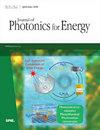减少热效应的太阳能泵浦复合 YAG/Ce:Nd:YAG/YAG 激光器
IF 2.1
4区 工程技术
Q4 MATERIALS SCIENCE, MULTIDISCIPLINARY
引用次数: 0
摘要
本研究报告了利用直径为 3 毫米的 YAG/Ce:Nd:YAG/YAG/rod 复合材料制造的太阳能泵浦激光器的实验测试结果。当激光器暴露在辐照度为 900 W/m2 的 593 W 入射太阳光下时,我们测得输出功率为 8.5 W,多模工作时的光-光转换效率为 1.43%。YAG/Ce:Nd:YAG/YAG复合激光棒经受住了太阳能末端泵浦数个小时的严酷测试条件,随着时间的推移,激光输出没有任何负面影响或衰减。为了解释和全面分析实验结果,我们在实验装置的基础上开发了一个仿真模型,并在计算中考虑了低激光级的热群体。模拟计算结果表明,实验中输入-输出依赖关系的直线偏差较小,这是因为低激光级的热群体影响较弱。为了与最近使用可比尺寸的传统激光棒所取得的成果进行比较,并在未来研究中使用复合晶体时提出一些有用的建议,我们进行了额外的数值实验,其中考虑到了可能的优化,但这些优化丝毫不影响本实验中所考虑的激光棒前部的热负荷。数值研究表明,当太阳能输入功率约为 600 W 时,使用 3 毫米激光棒可实现 4.0% 的太阳能-激光功率转换效率。根据这项研究的结果,我们得出结论:采用由具有复合结构的单杆或多杆系统组成的激光介质,有可能为太阳能泵浦固体激光器固有的热挑战提供最佳解决方案。本文章由计算机程序翻译,如有差异,请以英文原文为准。
Solar-pumped composite YAG/Ce:Nd:YAG/YAG laser with reduced thermal effects
This study reports experimental test results on a solar-pumped laser that utilizes composite YAG/Ce:Nd:YAG/YAG/rod with a diameter of 3 mm. We measured an output power of 8.5 W with optical-to-optical conversion efficiency of 1.43% in multimode operation when the laser was exposed to an incoming solar power of 593 W at an irradiance of 900 W/m2. The YAG/Ce:Nd:YAG/YAG composite laser rod withstood the severe conditions of solar end-pumping for several hours of testing without any negative effects or degradation of laser output over time. To interpret and comprehensively analyze the experimental results, we developed a simulation model based on our experimental setup and conducted calculations with taking into account thermal population of lower laser levels. Simulation calculations show that a small deviation from a straight line in the experimental input–output dependence is a consequence of the weak influence of thermal population of the lower laser levels. To compare with recent achievements with conventional laser rods of comparable sizes and to formulate some useful recommendations when using composite crystals in future studies, we carried out additional numerical experiments taking into account possible optimizations, which do not affect in any way the thermal load on the front part of the laser rod considered in this experiment. The numerical studies demonstrate that solar-to-laser power conversion efficiency of 4.0% is achievable with a 3 mm laser rod when the solar input power is about 600 W. We also discuss the influence of rod size and thermal effects on conversion efficiency. Based on the findings of this study, we conclude that employing laser media composed of a single or multirod system with a composite structure could potentially offer an optimal solution to the thermal challenges inherent in solar-pumped solid-state lasers.
求助全文
通过发布文献求助,成功后即可免费获取论文全文。
去求助
来源期刊

Journal of Photonics for Energy
MATERIALS SCIENCE, MULTIDISCIPLINARY-OPTICS
CiteScore
3.20
自引率
5.90%
发文量
28
审稿时长
>12 weeks
期刊介绍:
The Journal of Photonics for Energy publishes peer-reviewed papers covering fundamental and applied research areas focused on the applications of photonics for renewable energy harvesting, conversion, storage, distribution, monitoring, consumption, and efficient usage.
 求助内容:
求助内容: 应助结果提醒方式:
应助结果提醒方式:


